| Transnistria | |
| Flag | |
.svg/100px-Flag_of_Transnistria_(state).svg.png) | |
| Information | |
| Capital city | Tiraspol |
|---|---|
| Area | 4 163 km² |
| Population | 555 500 hab. |
| Density | 133,44 inhab./km² |
| Form of State | republic, presidential system |
| Change | Transnistrian ruble |
| Telephone prefix | 373 |
| Flow direction | Right-hand drive |
| Spindle | UTC 02:00, UTC 03:00, Eastern European Time |
| Location | |
 47 ° 15 ′ 36 ″ N 29 ° 21 ′ 36 ″ E | |
| http://vspmr.org/, http://gov-pmr.org/, http://supcourtpmr.org/ Official site | |
Transnistria (locally called by its Russian name, Pridnestrovie) is a state de facto in Eastern Europe which declared its independence from the Moldova. It is only recognized by the other breakaway states of the former Soviet Union - theAbkhazia, the Nagorno-Karabakh and theSouth Ossetia. It roughly corresponds to the territory between the Dniester and theUkraine.
Understand
The Moldovan Republic of the Dniester seceded from Moldova in 1991 when the latter gained independence from the USSR.
Transnistria is a product of the disorderly collapse of the Soviet Union, when a part of the newly formed Republic of Moldova that wished to remain in the Russian family rebelled against the domination of the Romanian language by Kishinev and decided to follow his own path.
Although the country is not officially recognized by any other sovereign nation, the government effectively controls the territory it claims to rule, although their actual room for maneuver is perhaps limited a bit by the will of Russia, their greatest. benefactor and political ally. It maintains its functional autonomy with military and other support from Russia.
Although Transnistria is not a classic tourist destination per se, it does offer a certain Stalinist charm and is one of the few "countries that do not exist" (at least according to the UN) that is not in or in proximity to a region of active conflict, to a war zone. So you can brag about having an entry stamp in your passport and tickets in your wallet that the rest of the world pretends not to know. And if it's not just for bragging rights, there are other attractions as well.
Geography
The territory of 4,163 km2 control de facto by the government of Tiraspol has an area equivalent to that of the French department of Eastern Pyrenees or the Belgian province of Luxembourg, but stretches, like a Chile miniature, between the Dniester river and the border between the Moldova and theUkraine.
The highest point of Transnistria (273.9 m) is located on the heights of the town of Plopi ("The poplars" in Moldovan, in Плоть).
Transnistria is divided into five administrative regions and two free cities.
History
The Moldovan Republic of Dniester (RMD) covers the historic Ukrainian regions of Podolia and Yedisan with the exception of the towns of Dubăsari and of Bendey/ Tighina, its territory belonged neither to the former Principality of Moldavia nor to the former Bessarabia.
On the other hand, in 1924, it was included in the Autonomous Moldovan Soviet Socialist Republic that the Soviets then created within the Ukrainian Soviet Socialist Republic. The Moldovan Autonomous Republic is made up of districts then populated mainly by Romanian speakers.
The , following the Russian ultimatum of with a delay of 24 hours, the USSR annexed Bessarabia which was then included in the autonomous republic of Moldavia, transformed into the Soviet socialist republic of Moldavia. From to , for 5 weeks, the RSSM includes the former RSSA of Moldova and Bessarabia (i.e. 52,710 km2).
The , the brand new Soviet Socialist Republic of Moldova is reduced by 40% of its initial territory and, among other things, loses 56% (4,800 km2) of its Transdniestrian territory. More or less, it corresponds (with 28,250 km2), to the current Republic of Moldova (which, since 1946, is a little more extensive: 33,843 km2). Thus, the Republic of Moldova today has within its internationally recognized borders only 62.8% of the territory that the RSSM possessed when it was founded in July 1940.
During World War II, in July 1941, Bessarabia was reoccupied by the Romania in connection with the invasion of Axis forces in the Soviet Union. In the same year, the Soviet territory between the Dniester and the Boug forms the Romanian "governorate" of Transnistria, with Odessa for capital. In 1942, this "governorate" of Transnistria had 1.2 million inhabitants (23% of whom were Romanian speakers), out of 44,000 km2. It is divided into 13 districts. Romanian speakers are numerous, especially in the west, in the Dniester basin.
The Red Army returned in March 1944 and Transnistria was reintegrated into the Soviet Union, which deported half of the Romanian speakers, accused of collusion with the fascist occupier. In the 1960s, the left bank of the Dniester became industrialized: the hydroelectric power station of Dubăsari, Colbasna arsenal, mechanical and other industries of Tiraspol. Many Russian speakers settle there.
The RMD secedes from the Moldova in 1991 when the latter became independent from the USSR in which the RMD wished to remain.
As the Soviet Union began to democratize in the late 1980s, he performed in Moldova, with the future RMD and the Gagauzia, a phenomenon similar to that observed later in Ukraine with the Crimea and the Donbass, in Georgia With l'Abkhazia and theSouth Ossetia, or in Azerbaijan with the Nagorno-Karabakh : in the face of the centrifugal and independence movements of Union republics (Moldova, Ukraine, Georgia, Azerbaijan), the Russian authorities encourage and support the autonomy of local minorities (Russian in Ukraine and Moldavia, Abkhaz and Ossetian in Georgia, Armenian in Azerbaijan). This has the effect of pitting the inhabitants against each other, and of posing the Soviet army as arbiter.
Tensions increase as much and , when the Parliament of the Republic of Moldova adopts the use of Romanian (language of the indigenous majority) as the only official language of the Republic, the Russo-Ukrainians, already alarmed since 1989 by the reintroduction of the Latin alphabet and the Moldovan desire to leave the Soviet fold, express their refusal to have to learn the language and their fear of losing their privileged position for linguistic reasons, as in the Baltic countries. In addition, a possible reunification between Romania and Moldova seems unacceptable for Slavophones (25.4% of the population in the Republic of Moldova, but who would be only 8% in a united Romania-Moldova). Also, the Slavophones of Transnistria gathered by Igor Smirnov, demand the maintenance of their region within the USSR and its attachment to the Soviet republic of Russia, as the enclave of Kaliningrad. The , they proclaim a "Moldavian Soviet Socialist Republic of the Dniester" which is not recognized by the Supreme Soviet of the USSR, because it did not exist before, Moldova having a unitary structure within the USSR, with 41 equal rights and all bilingual.
In November, violence broke out between the armed forces of the Republic of Moldova and the Russian-speaking militias of the RMD, the latter then being supported by the 14th Russian Army, which was permanently stationed in the territory. The new Moldovan Republic of the Dniester chooses Tiraspol as its capital and requests its attachment to the Russia.
In November 1991, in the context of the breakup of the USSR and the abandonment of communism, the country was renamed by the authorities of Tiraspol in the “Moldavian Republic of the Dniester” (RMD) and unofficially and partially abandoned the communist ideology. (at least in the economic field) to move towards a gradual transition to the market economy. During a first referendum held in December 1991, the people of the RMD voted for the independence of the territory.
In June 1992, the fighting resumed. The , a violent artillery fire on the Moldovan border guards (and on a civilian bus passing by, shots filmed by Olga Căpăţînă) near the forest of Hârbovăţ / Gerbovetskii to the north-west of Bender / Tighina killed 112 in the Moldovan ranks and marked the effective end of hostilities following this show of force.
A trilateral force from the KFC CIS peacekeeping mission (Russian, Moldovan and Transdniestrian) is deployed on along the Dniester and around Tighina.
In the autumn of 1992, negotiations lead to an agreement between the President of the Republic of Moldova Mircea Snegur and the President of the Russian Federation, Boris Yeltsin: Russia would remain neutral if the RMD enjoyed the status of an autonomous region within the framework of the Republic of Moldova: this is the birth of the "Autonomous Territorial Unit of the Left Bank of the Dniester" (UTAN) . In exchange, the Republic of Moldova undertakes to no longer claim its Romanian identity, not to request its attachment to the Romania or, in this case, to grant the right to self-determination to UTAN.
Population
The three official languages of Transnistria are Russian, state language spoken by all citizens, and mother tongue for 30.4% of them,Ukrainian spoken by 28.8% of them, and "Moldovan" (Romanian written in Cyrillic characters) which is the mother tongue of 31.9% of them. Thus the Transdniestrian population is divided globally into three thirds, Russians, Ukrainians and Moldovans, with Polish minorities in the North, Bulgarians and Armenians in Tiraspol.
The national identity of Transnistria was built on the commemoration of the anti-fascist struggles of the “Great Patriotic War”, on the opposition to Moldovan-Romanian unionism portrayed as “fascist” and to European influence portrayed as subservient. to large international capital.
Weather
Holidays
Cities

- 1 Bendery (Tighina) – Bender Fortress is used as a military training ground and is prohibited. The best views are from the bridge going towards Tiraspol.
- 2 Rîbnița
- 3 Tiraspol – Capital of the separatist republic.
Other Destinations
To go
Formalities

Entering Transnistria is quite easy by bus, train or car both from the west (Moldova, Chișinău usually) and east (Ukraine, Odessa in general). When entering Transnistria you will need to complete a printed registration card in Russian and in English. During the police check at the border crossing, this card, not your passport, is stamped - half of the card is kept at the border post you entered, and the second part should be kept with you until you never left Transnistria.
When crossing the border between Moldova and Transnistria, you will only be checked by officials from Transnistria. There are also Russian and Ukrainian peacekeepers who can stop and search vehicles.
When entering Transnistria from Ukraine, you will not get a Moldovan entry stamp. If you leave Moldova through a border post controlled by the Moldovan authorities, you may have problems with the Moldovan immigration authorities, who may accuse you of entering Moldova illegally. Leaving Moldova through Transnistria to Ukraine (with or without a Moldovan entry stamp) poses no problem - A subsequent visit to Moldova through one of the border posts controlled by the Moldovan authorities does not raise any problems with the border guards.
Transnistrian authorities could try to extort bribes from travelers at the borders, especially on the main road connecting Odessa at Chișinău. Be firm, fearless, and polite in insisting that you don't have to pay to enter or leave their country (unless you drive your own vehicle, which incurs a 5 $ at the entrance). It might seem intimidating - nowhere else can you be questioned by the KGB wearing hammer and sickle badges, but bribes are not officially tolerated and they will give in. Don't let the guards see your money, it will make them want it. If you feel beaten up and find that paying a bribe is the best solution, keep it low: 1 € should suffice.
The best way to combat this corruption is to know ahead of time what might be going on and be prepared for any games the guards might participate in. Write a short text stating that you know their tips and how they work and that it is not necessary to have a Moldovan exit visa. Translate this into Russian while providing a few of the complaint phone numbers listed below to show them you're serious. Also, make sure you have multiple copies of this document, as they will likely confiscate the first version you give them.
- State Customs Committee ,
 373 533 94578, email: [email protected] – Complaints can be made online, go to the English version and click on "hot line". You can also send a complaint to [email protected] (Transdniestrian customs). Future travelers will be grateful for your complaint! There is also a complaint helpline: (373 533 94578 or 92568). Try to memorize the agent's number before asking for a bribe. Even the friendliest of agents can be corrupted! If you have a complaint, you must also indicate the time, date and name of the border post. Also enter your phone number. An English speaking agent is responsible for complaints. You can reach him at [email protected] or 373 778 50986
373 533 94578, email: [email protected] – Complaints can be made online, go to the English version and click on "hot line". You can also send a complaint to [email protected] (Transdniestrian customs). Future travelers will be grateful for your complaint! There is also a complaint helpline: (373 533 94578 or 92568). Try to memorize the agent's number before asking for a bribe. Even the friendliest of agents can be corrupted! If you have a complaint, you must also indicate the time, date and name of the border post. Also enter your phone number. An English speaking agent is responsible for complaints. You can reach him at [email protected] or 373 778 50986
By plane
Transnistria does not have its own international passenger airport (it has a military and freight airport), so the best way is to take a plane to Chișinău in Moldova. It is also possible to come from the airport ofOdessa in Ukraine by bus.
On a boat
By train
By bus
From Chișinău: You have to leave from Chișinău bus station, located in the city. Buy your ticket at the ticket office and take a bus or machrutka that will take you to Tiraspol. The journey lasts about an hour and a half where you will be checked by the Transdniestrian customs officers who will give you your visa, then a stopover in Bender in the separatist zone. To return to Chișinău, buy your ticket from Tiraspol station. A one-way ticket costs between two and three euros.
By car
Circulate

To speak
The official languages in Transnistria are the Russian, the Moldovan (which is basically the same as Romanian), and theUkrainian. Transnistrian Moldovan is spelled using the Cyrillic alphabet, although some people use the spelling with the Latin alphabet, which is a matter of dispute. The most common language used in shops, bars, and taxis is Russian, which is understood by virtually everyone. Moldovan and Ukrainian are also widely understood and spoken, but to a lesser extent.
To buy

Transnistria issues its own currency, the Transnistrian ruble.
- National Bank of Transnistria – The site indicates the daily rate in the main currencies.
Eat
Have a drink / Go out
Housing
To learn
To work
Communicate
Security
 | Emergency telephone number: Police :102 Ambulance:103 Firefighter :101 |
Health
Respect
| Exclusion from Transnistria of the regional hierarchy of Moldova can in no way be considered as political support to one of the parties to the conflict relating to its sovereignty. This purely practical distinction is due to the fact that the travel conditions in this region are very different from those in the rest of Moldova. |
